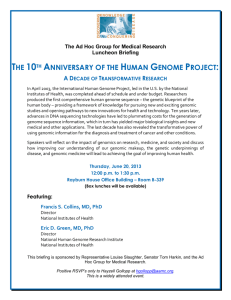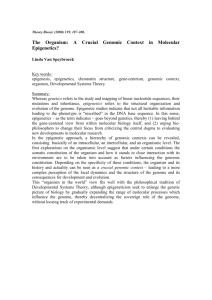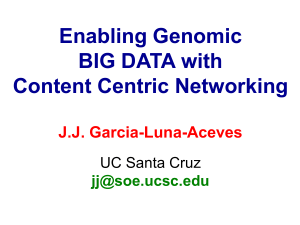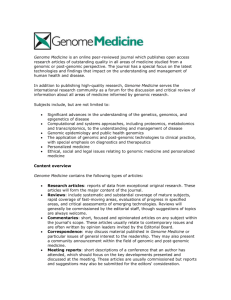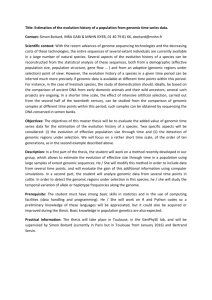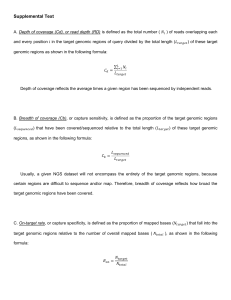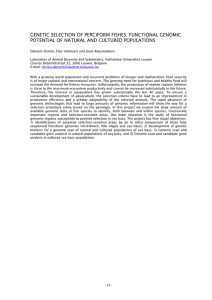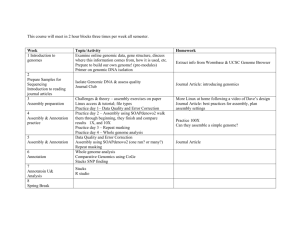Genomic data lab exercises
advertisement
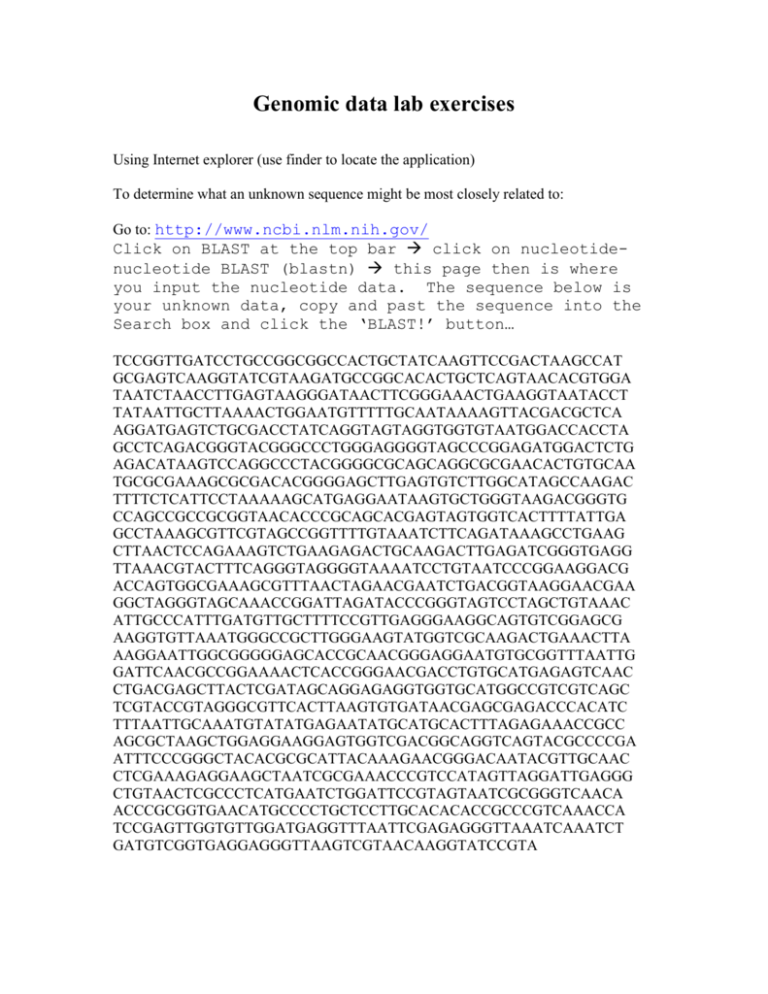
Genomic data lab exercises Using Internet explorer (use finder to locate the application) To determine what an unknown sequence might be most closely related to: Go to: http://www.ncbi.nlm.nih.gov/ Click on BLAST at the top bar click on nucleotidenucleotide BLAST (blastn) this page then is where you input the nucleotide data. The sequence below is your unknown data, copy and past the sequence into the Search box and click the ‘BLAST!’ button… TCCGGTTGATCCTGCCGGCGGCCACTGCTATCAAGTTCCGACTAAGCCAT GCGAGTCAAGGTATCGTAAGATGCCGGCACACTGCTCAGTAACACGTGGA TAATCTAACCTTGAGTAAGGGATAACTTCGGGAAACTGAAGGTAATACCT TATAATTGCTTAAAACTGGAATGTTTTTGCAATAAAAGTTACGACGCTCA AGGATGAGTCTGCGACCTATCAGGTAGTAGGTGGTGTAATGGACCACCTA GCCTCAGACGGGTACGGGCCCTGGGAGGGGTAGCCCGGAGATGGACTCTG AGACATAAGTCCAGGCCCTACGGGGCGCAGCAGGCGCGAACACTGTGCAA TGCGCGAAAGCGCGACACGGGGAGCTTGAGTGTCTTGGCATAGCCAAGAC TTTTCTCATTCCTAAAAAGCATGAGGAATAAGTGCTGGGTAAGACGGGTG CCAGCCGCCGCGGTAACACCCGCAGCACGAGTAGTGGTCACTTTTATTGA GCCTAAAGCGTTCGTAGCCGGTTTTGTAAATCTTCAGATAAAGCCTGAAG CTTAACTCCAGAAAGTCTGAAGAGACTGCAAGACTTGAGATCGGGTGAGG TTAAACGTACTTTCAGGGTAGGGGTAAAATCCTGTAATCCCGGAAGGACG ACCAGTGGCGAAAGCGTTTAACTAGAACGAATCTGACGGTAAGGAACGAA GGCTAGGGTAGCAAACCGGATTAGATACCCGGGTAGTCCTAGCTGTAAAC ATTGCCCATTTGATGTTGCTTTTCCGTTGAGGGAAGGCAGTGTCGGAGCG AAGGTGTTAAATGGGCCGCTTGGGAAGTATGGTCGCAAGACTGAAACTTA AAGGAATTGGCGGGGGAGCACCGCAACGGGAGGAATGTGCGGTTTAATTG GATTCAACGCCGGAAAACTCACCGGGAACGACCTGTGCATGAGAGTCAAC CTGACGAGCTTACTCGATAGCAGGAGAGGTGGTGCATGGCCGTCGTCAGC TCGTACCGTAGGGCGTTCACTTAAGTGTGATAACGAGCGAGACCCACATC TTTAATTGCAAATGTATATGAGAATATGCATGCACTTTAGAGAAACCGCC AGCGCTAAGCTGGAGGAAGGAGTGGTCGACGGCAGGTCAGTACGCCCCGA ATTTCCCGGGCTACACGCGCATTACAAAGAACGGGACAATACGTTGCAAC CTCGAAAGAGGAAGCTAATCGCGAAACCCGTCCATAGTTAGGATTGAGGG CTGTAACTCGCCCTCATGAATCTGGATTCCGTAGTAATCGCGGGTCAACA ACCCGCGGTGAACATGCCCCTGCTCCTTGCACACACCGCCCGTCAAACCA TCCGAGTTGGTGTTGGATGAGGTTTAATTCGAGAGGGTTAAATCAAATCT GATGTCGGTGAGGAGGGTTAAGTCGTAACAAGGTATCCGTA This page allows you to format the data, for now let’s use the defaults – click ‘FORMAT!’ to process this data. Major features of this output: Reference information Graphical display of matches – lines represent an alignment score, longer ones are other organisms that line up well with your sequence – color coded. Text list of possible matches and a ‘score’ which includes an accession number (unique ID for each sequence) – clicking on that gives more data, the paper or ref it pertains to (PUBMED can give you a direct link to the paper) – on this page get info on where this data came from (isolate, environ. Sequence, etc..), - it does not say what primers were used (can get that in the original paper only…) Hitting the score link takes you to the part of the page with the specific sequence (lines are matches) – Identities section gives you the % of how it matches (mismatches – Y, R – these are analytical uncertainty usually) – also look for gaps here, sections that do not match in length (next one down has them (gaps are dashes in the sequences) Beneath the graphic output can click on ‘distance tree of results’ which makes a phylogentic tree representation of this data! check out what the sequence most likely represents and what other known organisms are closely related… --------------------------------------------------------------------------------------------------------Now let’s investigate some of the data repositories where genomic data is catalogued: http://www.ncbi.nlm.nih.gov/ is the link to the National Center for Biotechnology Information and is one of the main repositories for genetic data – where researchers deposit data (GenBank) http://www.jgi.doe.gov/ is the link to the Joint Genome Institute (DOE) http://www.tigr.org/ is The Institute for Genomic Research (Craig Venter’s company) http://cmr.tigr.org/tigr-scripts/CMR/CmrHomePage.cgi is the tool for comparing and finding genmic data http://rdp.cme.msu.edu/ - ribosomal database project – good place for 16S database and classifying 16S genomic data Think about an organism you are interested in and let’s try to find: Is the genome available? How big is the genome (or fragment) that has been sequenced? Where did the sample come from? Are there genomes for organisms closely related to this? Start at the JGI database and try to find an organism
